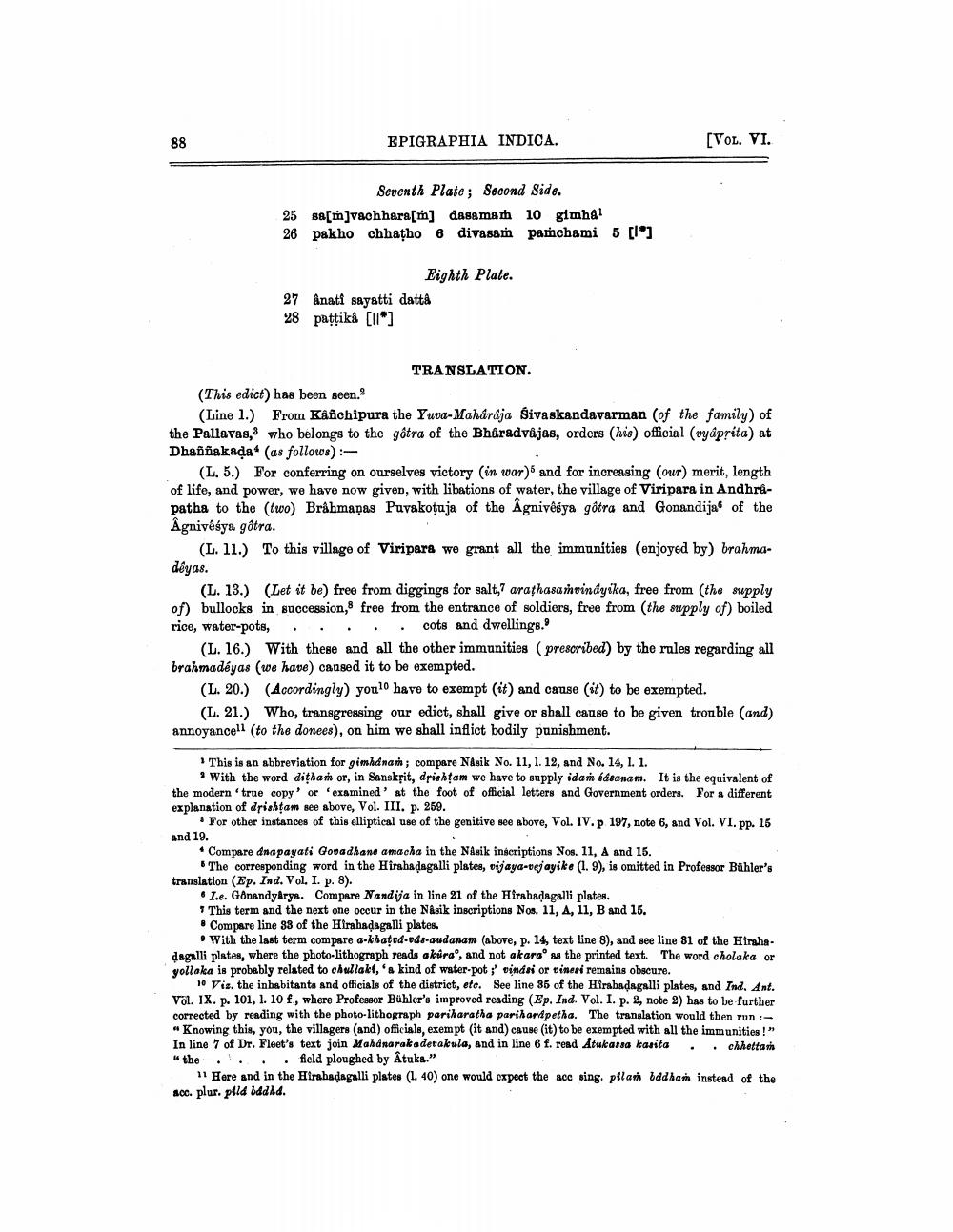________________
EPIGRAPHIA INDICA.
[Vol. VI.
Seventh Plate; Second Side. 25 sa[m]vachhara[m] dasamam 10 gimna! 26 pakho chhatho 8 divasam pamchami 5 [1]
Eighth Plate. 27 Ânati sayatti datta 28 pattika [11]
TRANSLATION.
(This edict) has been seen.
(Line 1.) From Kanchipura the Yuva Maharaja Sivaskandavarman (of the family) of the Pallavas, who belongs to the gôtra of the Bharadvajas, orders (his) official (vyáprita) at Dhanbakada* (as follows) -
(L. 5.) For conferring on ourselves victory (in war) and for increasing (our) merit, length of life, and power, we have now given, with libations of water, the village of Viripara in Andhrapatha to the two) Brahmanas Puvakoguja of the Agnivê ya gôtra and Gonandija of the Agnivèsya gôtra.
(L. 11.) To this village of Viripars we grant all the immunities (enjoyed by) brahmadéyas.
(L. 13.) (Let it be free from diggings for salt,7 arathasamvináyika, free from the supply of) bullocks in succession, free from the entrance of soldiers, free from the supply of) boiled rice, water-pots, . . . . . cots and dwellings.
(L. 16.) With these and all the other immunities (prescribed by the rules regarding all brahmadéyas (we have caused it to be exempted.
(L. 20.) (Accordingly) youl0 have to exempt (it) and cause (it) to be exempted.
(L. 21.) Who, transgressing our edict, shall give or shall cause to be given trouble (and) annoyancell (to the donees), on him we shall inflict bodily punishment.
This is an abbreviation for gimhanan; compare Násik No. 11, 1. 12, and No. 14, 1. 1.
. With the word dithan or, in Sanskrit, drishtam we have to supply idam idsanam. It is the equivalent of the modern true copy' or 'examined' at the foot of official letters and Government orders. For a different explanation of drishtam see above, Vol. III. p. 259.
• For other instances of this elliptical use of the genitive see above, Vol. IV. p 197, note 6, and Vol. VI. pp. 15 and 19.
• Compare anapayati Gopadhana amacha in the Nasik inscriptions Nos. 11, A and 15.
The corresponding word in the Hirabadagalli plates, vijaya-vejayike (1.9), is omitted in Professor Bühler's translation (Ep. Ind. Vol. I. p. 8).
. 1.e. GônandyArya. Compare Nandija in line 21 of the Hirahadagalli plates. * This term and the next one occur in the Nasik inscriptions Nos. 11, A, 11, B and 16. . Compare line 33 of the Hirahadagalli plates.
. With the last term compare a-khatra-rás-oudanam (above, p. 14, text line 8), and see line 81 of the Hirahadagalli plates, where the photo-lithograph reads akúra", and not akarao as the printed text. The word cholaka or yollaka is probably related to chullaki, a kind of water-pot;' binasi or vinesi remains obscure.
10 Viz the inhabitants and officials of the district, etc. See line 85 of the Hirahadagalli plates, and Ind. Ant. Vol. IX. p. 101, 1. 10 f, where Professor Buhler's improved reading (Ep. Ind. Vol. I. p. 2, note 2) has to be further corrected by reading with the photo-lithograph pariharatha parihardpetha. The translation would then run :"Knowing this, you, the villagers (and) officials, exempt it and) cause (it) to be exempted with all the immunities!" In line 7 of Dr. Fleet's text join Mahdnarak adevakula, and in line 6 f. read Atukassa kasita . chhetta "the .!. field ploughed by Atuks."
11 Here and in the Hirahadagalli plates (1. 40) one would expect the acc sing pilan badham instead of the acc. plur. pila badhd.




